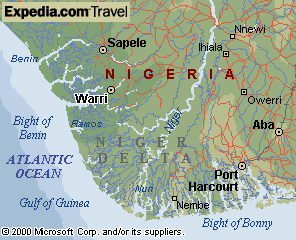Flying the Cessna Caravan in
West Africa:
![]() On a typical hot humid and
windless West African day, I taxi the Chevron floatplane down the muddy
brown river against the incoming tide. Several natives in antiquated dug-out
canoes paddle along downstream, waiting expectantly for me to pass, but not
giving way. I apply power and allow the aircraft to find it's own way onto
the step. Snaking the aircraft on down the flat calm river until airspeed
breaks the surface tension, I climb out at a steady 82 knots into the still
air. The rainforest, lush, green, and alive, spreads out before me. Despite
it's untouched appearance, the forest below is a creation of man's
endeavors. As seen from above, the once virgin rainforest is fast
disappearing. The West Africa landscape is a creation of man; a habitant of
mankind.
On a typical hot humid and
windless West African day, I taxi the Chevron floatplane down the muddy
brown river against the incoming tide. Several natives in antiquated dug-out
canoes paddle along downstream, waiting expectantly for me to pass, but not
giving way. I apply power and allow the aircraft to find it's own way onto
the step. Snaking the aircraft on down the flat calm river until airspeed
breaks the surface tension, I climb out at a steady 82 knots into the still
air. The rainforest, lush, green, and alive, spreads out before me. Despite
it's untouched appearance, the forest below is a creation of man's
endeavors. As seen from above, the once virgin rainforest is fast
disappearing. The West Africa landscape is a creation of man; a habitant of
mankind.
Click on the images for a
larger view.
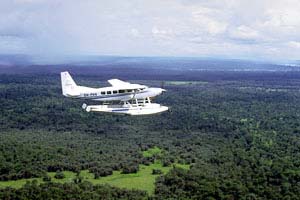
![]() To
better understand why operating a Cessna 208 Amphibious Caravan is so
special in West Africa, you would have to have some idea of the landscape
involved. Nigeria's namesake river, the Niger, flows through the heart of
the country to spread out fan like before the warm Atlantic waters. The
Niger Delta is a large expanse of natural waterways, flooded rainforest, and
tidal mangrove swamps, where thousands of Nigerians make their home and etch
out their subsistence life styles: diving for giant river snails, netting
ancient species of large scale fish, or harvesting their crops of cassava
and plantain from what high ground they can find. Although not immediately
evident, more and more the villagers are turning to the devastating industry
of logging to make their living.
To
better understand why operating a Cessna 208 Amphibious Caravan is so
special in West Africa, you would have to have some idea of the landscape
involved. Nigeria's namesake river, the Niger, flows through the heart of
the country to spread out fan like before the warm Atlantic waters. The
Niger Delta is a large expanse of natural waterways, flooded rainforest, and
tidal mangrove swamps, where thousands of Nigerians make their home and etch
out their subsistence life styles: diving for giant river snails, netting
ancient species of large scale fish, or harvesting their crops of cassava
and plantain from what high ground they can find. Although not immediately
evident, more and more the villagers are turning to the devastating industry
of logging to make their living.
![]() The Niger Delta is a timeless
landscape that the natives here call "the bush", and one that
bush-pilots, like myself, call home. Levelling out at 2000 feet ASL, I find
the early morning scene breath-taking. The mist has dissipated over the
water leaving a harmattan dust laden haze throughout the lower atmosphere
that glows a golden brown in the rich morning light. Hanging precipitously
over the horizon, the sun, obscured by the haze, forms a perfect purple disk
that glows from within. The harmattan dust, blown in from the Sahara, will
continue with the upper winds across the Atlantic, to become the soil of
bromeliads growing in the canopy of the Amazon rainforest. The desolation of
the Sahara feeds the richness of the Amazonos, as well as the Niger River
delta.
The Niger Delta is a timeless
landscape that the natives here call "the bush", and one that
bush-pilots, like myself, call home. Levelling out at 2000 feet ASL, I find
the early morning scene breath-taking. The mist has dissipated over the
water leaving a harmattan dust laden haze throughout the lower atmosphere
that glows a golden brown in the rich morning light. Hanging precipitously
over the horizon, the sun, obscured by the haze, forms a perfect purple disk
that glows from within. The harmattan dust, blown in from the Sahara, will
continue with the upper winds across the Atlantic, to become the soil of
bromeliads growing in the canopy of the Amazon rainforest. The desolation of
the Sahara feeds the richness of the Amazonos, as well as the Niger River
delta.
![]() Through the shallow ground fog
still lingering over the land, stand raffia palm trees, looking like proud
warriors in elaborate feathered head-dresses erect in a smoking razed field.
This visual effect is strengthened by the presence of blazing orange flares
burning throughout the oilfields beyond. I feel like an alien witness to a
primordial ritual dance carried out to please some mysterious and cruel god
that watches over this brutal but starkly beautiful land. I dance too. A
slow waltz, step by step, drifting toward the next horizon with my
floatplane.
Through the shallow ground fog
still lingering over the land, stand raffia palm trees, looking like proud
warriors in elaborate feathered head-dresses erect in a smoking razed field.
This visual effect is strengthened by the presence of blazing orange flares
burning throughout the oilfields beyond. I feel like an alien witness to a
primordial ritual dance carried out to please some mysterious and cruel god
that watches over this brutal but starkly beautiful land. I dance too. A
slow waltz, step by step, drifting toward the next horizon with my
floatplane.
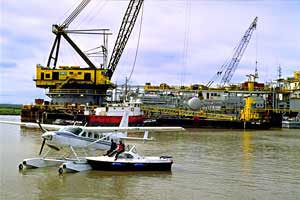
![]() Setting the GPS
for Ogbelle, toward the north west, I land 20 minutes later on a narrow
winding river. Here the red mangroves reach 200-250 feet above the
rainforest floor, with some emergents reaching even higher. When descending
below the canopy, the effect is like landing in a canyon where the trees are
the walls, and the walls are no more than 10 meters off each wing tip. The
water is so clear I can see the sandy bottom 2-3 meters down. White
water-lilies bloom below the still surface. I set up for a glassy water
landing using the fishermen in their dugout canoes as depth reference. They
duck their heads as I descend. In areas I fly to regularly, the fishermen
wear hardhats.
Setting the GPS
for Ogbelle, toward the north west, I land 20 minutes later on a narrow
winding river. Here the red mangroves reach 200-250 feet above the
rainforest floor, with some emergents reaching even higher. When descending
below the canopy, the effect is like landing in a canyon where the trees are
the walls, and the walls are no more than 10 meters off each wing tip. The
water is so clear I can see the sandy bottom 2-3 meters down. White
water-lilies bloom below the still surface. I set up for a glassy water
landing using the fishermen in their dugout canoes as depth reference. They
duck their heads as I descend. In areas I fly to regularly, the fishermen
wear hardhats.
![]() I land a little long, but use the
reverse pitch to slow quickly. After falling off the step, I glide the
aircraft nose first into a native village clearing to drop off the Chevron
drill rig workers. The entire village, including up to two hundred very
excited school age children, has come down to see the spectacle; "Ayibos,
(white men) arriving in a flying canoe."
I land a little long, but use the
reverse pitch to slow quickly. After falling off the step, I glide the
aircraft nose first into a native village clearing to drop off the Chevron
drill rig workers. The entire village, including up to two hundred very
excited school age children, has come down to see the spectacle; "Ayibos,
(white men) arriving in a flying canoe."
![]() Oh, what a sight. Hundreds of
bare chested young men, weathered old women in their threadbare wrappers,
and scores of naked and nearly naked swollen-bellied children, all black as
black can be from the tropical sun. Little hands reaching out to touch white
skin and painted white aluminum. For the children, it's their first
experience of either. The women and children are laughing and clapping, and
with the slightest encouragement on my part they all break out singing. They
love to sing. The old women add their part by shaking their hips in a native
dance.
Oh, what a sight. Hundreds of
bare chested young men, weathered old women in their threadbare wrappers,
and scores of naked and nearly naked swollen-bellied children, all black as
black can be from the tropical sun. Little hands reaching out to touch white
skin and painted white aluminum. For the children, it's their first
experience of either. The women and children are laughing and clapping, and
with the slightest encouragement on my part they all break out singing. They
love to sing. The old women add their part by shaking their hips in a native
dance.
![]() After pushing off into deeper
water and making sure the prop is clear of bobbing heads, I wave goodbye to
more cheering and clapping, and fire up the Caravan. Hearing that familiar
hushed whine and smelling the slight whiff of burning Jet A1, brings me back
to reality and I manoeuvre the floatplane down the narrow river and into the
sky. The next time I visit Ogbelle, the juju priest has erected a shrine to
commemorate the time the flying canoe came down from the sky. The shrine
consists of a white rag flag tied to a galvanized pipe stuck in the ground.
The priest, naturally, asks the oil company for payment to use this now
sacred landing. This landscape is their domain, and the villagers will
extract payment for trespasses.
After pushing off into deeper
water and making sure the prop is clear of bobbing heads, I wave goodbye to
more cheering and clapping, and fire up the Caravan. Hearing that familiar
hushed whine and smelling the slight whiff of burning Jet A1, brings me back
to reality and I manoeuvre the floatplane down the narrow river and into the
sky. The next time I visit Ogbelle, the juju priest has erected a shrine to
commemorate the time the flying canoe came down from the sky. The shrine
consists of a white rag flag tied to a galvanized pipe stuck in the ground.
The priest, naturally, asks the oil company for payment to use this now
sacred landing. This landscape is their domain, and the villagers will
extract payment for trespasses.
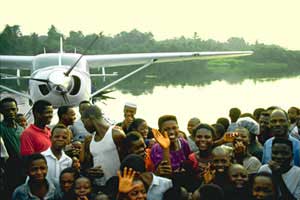
![]() The next stop is
Idama, a new Chevron flow station along a strong tidal river near the ocean.
The water is a silt laden brown, washing soil from inland out to the
Atlantic. It is this silt that builds the Niger Delta ever outward. The
villages here are poor. The houses are built with woven grass and palm
fronds. They appear flimsy and crooked, with dirt floors and no windows or
doors. Just openings to the hot delta breezes. The inhabitants are dressed
in threadbare cloth wrappers, or shorts and t-shirts, with many of them
being basically naked. They are happy to see me. About 30-35 villagers
gather to wave and laugh as I dance about the float busy setting my anchor.
The next stop is
Idama, a new Chevron flow station along a strong tidal river near the ocean.
The water is a silt laden brown, washing soil from inland out to the
Atlantic. It is this silt that builds the Niger Delta ever outward. The
villages here are poor. The houses are built with woven grass and palm
fronds. They appear flimsy and crooked, with dirt floors and no windows or
doors. Just openings to the hot delta breezes. The inhabitants are dressed
in threadbare cloth wrappers, or shorts and t-shirts, with many of them
being basically naked. They are happy to see me. About 30-35 villagers
gather to wave and laugh as I dance about the float busy setting my anchor.
![]() I've met the King of Idama. He is
a young ambitious king, who hopes the oil revenue will make up for their
depleted fish stocks. Just a few years back, the villagers would net huge 20
kilo red snappers that had come up the tidal salt rivers to feed. I never
see these big fish anymore. Too many fishermen with too many nets with too
many mouths to feed. My passenger, a Chevron engineer, does not stay long
and we are soon airborne again for the head office in Lekki.
I've met the King of Idama. He is
a young ambitious king, who hopes the oil revenue will make up for their
depleted fish stocks. Just a few years back, the villagers would net huge 20
kilo red snappers that had come up the tidal salt rivers to feed. I never
see these big fish anymore. Too many fishermen with too many nets with too
many mouths to feed. My passenger, a Chevron engineer, does not stay long
and we are soon airborne again for the head office in Lekki.
![]() Late in the afternoon a line
squall, approaching from the north-east, announces it's presence with a huge
wall of billowing black cloud, and probing gusts of cold turbulent wind. The
rain begins like village drummers beating an incessant rhythm for the
funeral of a tribal chief. The visibility quickly drops in the unbelievably
heavy rain. So heavy that you can barely make out the Caravan safely tied
down with herc straps just meters in front of the airport building. With the
colour radar and storm scope I saw the front moving in from the east, as I
was flying down from Lagos. I landed at the Escravos oil terminal for fuel
and wisely decided to wait out the ensuing storm.
Late in the afternoon a line
squall, approaching from the north-east, announces it's presence with a huge
wall of billowing black cloud, and probing gusts of cold turbulent wind. The
rain begins like village drummers beating an incessant rhythm for the
funeral of a tribal chief. The visibility quickly drops in the unbelievably
heavy rain. So heavy that you can barely make out the Caravan safely tied
down with herc straps just meters in front of the airport building. With the
colour radar and storm scope I saw the front moving in from the east, as I
was flying down from Lagos. I landed at the Escravos oil terminal for fuel
and wisely decided to wait out the ensuing storm.
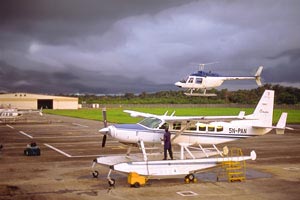
![]() Just as you think
the rain could not possibly get any harder, it doubles in intensity. The
noise drowns out all conversation, and in awe you feel impotent to say
anything anyway. A fire ball of lightning strikes a holding tank for the
crude oil, lighting the vents on fire. Thunder shakes the building, followed
by the wail of the fire response team's sirens. We are always trying to
control our environment, but at this moment I feel the control slipping
away.
Just as you think
the rain could not possibly get any harder, it doubles in intensity. The
noise drowns out all conversation, and in awe you feel impotent to say
anything anyway. A fire ball of lightning strikes a holding tank for the
crude oil, lighting the vents on fire. Thunder shakes the building, followed
by the wail of the fire response team's sirens. We are always trying to
control our environment, but at this moment I feel the control slipping
away.
![]() After the winter "dry"
season the rainy season has begun. In my view there are really four seasons
in Nigeria. There is the Harmattan season, when cold winds blow from the
Sahara, bringing with them desert dust and fine sand. The other three
seasons are: the beginning of the rainy season, the rainy season, and the
end of the rainy season. They each last about three months, and it's hard to
tell one from the other. That evening, just after the sun sets, the sky
washes out into the electric energy of purple haze. I can't help thinking of
Jimmy Hendrix. He must have known something we do not. Although he had never
been here, West Africa was his birthplace. As Africa was for all of us. He
understood the connectivity of energy that emanates from us all. And here in
Nigeria, the warmth and breath of humanity is felt by the proximity of
community. Over 100 million Nigerians living off the land of their small,
but powerful country. Collectively they shape their invigorating and lively
landscape.
After the winter "dry"
season the rainy season has begun. In my view there are really four seasons
in Nigeria. There is the Harmattan season, when cold winds blow from the
Sahara, bringing with them desert dust and fine sand. The other three
seasons are: the beginning of the rainy season, the rainy season, and the
end of the rainy season. They each last about three months, and it's hard to
tell one from the other. That evening, just after the sun sets, the sky
washes out into the electric energy of purple haze. I can't help thinking of
Jimmy Hendrix. He must have known something we do not. Although he had never
been here, West Africa was his birthplace. As Africa was for all of us. He
understood the connectivity of energy that emanates from us all. And here in
Nigeria, the warmth and breath of humanity is felt by the proximity of
community. Over 100 million Nigerians living off the land of their small,
but powerful country. Collectively they shape their invigorating and lively
landscape.
![]() Since the 1950's,
many different companies have attempted to operate floatplanes (sometimes
called seaplanes) in Nigeria. Shell Oil had a Beaver, McDermott a Widgeon
(technically a flying boat), and Delta Air Charter a Cessna 180, plus a
couple of Cessna 185's. With management change-outs and prosperity in the
oil fields, attitudes changed. The floatplanes were phased out and replaced
with very expensive twin engine helicopters. The oil companies spared no
expense in building large lighted helipads at every existing location.
Since the 1950's,
many different companies have attempted to operate floatplanes (sometimes
called seaplanes) in Nigeria. Shell Oil had a Beaver, McDermott a Widgeon
(technically a flying boat), and Delta Air Charter a Cessna 180, plus a
couple of Cessna 185's. With management change-outs and prosperity in the
oil fields, attitudes changed. The floatplanes were phased out and replaced
with very expensive twin engine helicopters. The oil companies spared no
expense in building large lighted helipads at every existing location.
![]() One very practical company,
however, Willbros Nigeria Ltd., an oil pipeline contractor based out of
Tulsa Oklahoma, has continued to successfully operate a floatplane in
Nigeria since 1979. In fact, one of the Managing Directors of Willbros
called the floatplane, the best kept secret in Nigeria.
One very practical company,
however, Willbros Nigeria Ltd., an oil pipeline contractor based out of
Tulsa Oklahoma, has continued to successfully operate a floatplane in
Nigeria since 1979. In fact, one of the Managing Directors of Willbros
called the floatplane, the best kept secret in Nigeria.
![]() His reasons were simple. The
floatplane can service virtually any work site in the oil rich delta region.
Moreover, the floatplane is one of the safest, most comfortable, and most
cost effective means of transportation in the delta. And fast as well. Few
people realize how useful and efficient this method of transport really is
for the swamps and oil fields of Nigeria.
His reasons were simple. The
floatplane can service virtually any work site in the oil rich delta region.
Moreover, the floatplane is one of the safest, most comfortable, and most
cost effective means of transportation in the delta. And fast as well. Few
people realize how useful and efficient this method of transport really is
for the swamps and oil fields of Nigeria.
![]() The Caravan has certainly helped
the floatplane earn it's way back into the realms of the Nigerian oil
service industry. Today, with oil prices remaining stagnant and the cost of
development inflating, oil companies and oil service contractors are looking
for ways to reduce costs without eroding service or safety standards, and
the Caravan does just that.
The Caravan has certainly helped
the floatplane earn it's way back into the realms of the Nigerian oil
service industry. Today, with oil prices remaining stagnant and the cost of
development inflating, oil companies and oil service contractors are looking
for ways to reduce costs without eroding service or safety standards, and
the Caravan does just that.
![]() Chevron discovered this when they
arranged a contract with Pan African Airlines to bring in and operate a
Cessna 208 Amphibian Caravan. After using the aircraft for almost three
years now, everyone, from the top management down, is delighted with the
service. In fact, Chevron management has confided that they cannot imagine
having to go back to the way they did business before they got the Caravan.
Chevron discovered this when they
arranged a contract with Pan African Airlines to bring in and operate a
Cessna 208 Amphibian Caravan. After using the aircraft for almost three
years now, everyone, from the top management down, is delighted with the
service. In fact, Chevron management has confided that they cannot imagine
having to go back to the way they did business before they got the Caravan.
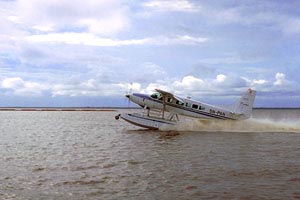
![]() Normally, Chevron
would have discounted a single engine aircraft to meet their needs of flying
across hundreds of miles of ocean, swamp, and rain forest. Combining the
Whipline amphibian floats with the Caravan I, however, meets those needs
better than any other aircraft produced today.
Normally, Chevron
would have discounted a single engine aircraft to meet their needs of flying
across hundreds of miles of ocean, swamp, and rain forest. Combining the
Whipline amphibian floats with the Caravan I, however, meets those needs
better than any other aircraft produced today.
![]() First of all, the Caravan's PT6
turbine is simply the safest and most reliable powerplant anywhere.
Secondly, with fixed wings and very few moving parts the chances of
breakdown are minimized. Moreover, should an emergency or precautionary
situation arise, the Caravan's 52 foot wing span and incredible glide ratio
gives this amphibious aircraft almost unlimited landing areas.
First of all, the Caravan's PT6
turbine is simply the safest and most reliable powerplant anywhere.
Secondly, with fixed wings and very few moving parts the chances of
breakdown are minimized. Moreover, should an emergency or precautionary
situation arise, the Caravan's 52 foot wing span and incredible glide ratio
gives this amphibious aircraft almost unlimited landing areas.
![]() The newly designed and built
Caravan is also equipped with state of the art safety features and
instrumentation that places it within the newly recognized category of
single engine IFR day or night commercial passenger capability. The Cessna
Caravan was the first aircraft in the world to meet the stringent
requirements for this recognition, and within Nigerian regulations that
category is fully utilized.
The newly designed and built
Caravan is also equipped with state of the art safety features and
instrumentation that places it within the newly recognized category of
single engine IFR day or night commercial passenger capability. The Cessna
Caravan was the first aircraft in the world to meet the stringent
requirements for this recognition, and within Nigerian regulations that
category is fully utilized.
![]() Despite meeting and exceeding
these safety standards, the Caravan still accounts for a fraction of what it
costs to operate and maintain a rotary wing aircraft and, understandably,
less than any twin engine aircraft. Although for servicing off-shore
platforms there is no substitute for the helicopter, on-shore the Caravan
becomes a viable means of transport and communications.
Despite meeting and exceeding
these safety standards, the Caravan still accounts for a fraction of what it
costs to operate and maintain a rotary wing aircraft and, understandably,
less than any twin engine aircraft. Although for servicing off-shore
platforms there is no substitute for the helicopter, on-shore the Caravan
becomes a viable means of transport and communications.
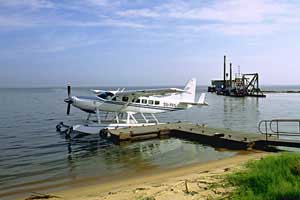
![]() Two of the
Swedish engineers employed by Pan African Airlines to maintain the Caravan
have plenty of good things to say about this aircraft. With over 2800 hours
of flight time in two and one half years, the Caravan still holds a 99%
dispatch rate. In addition, the amphibious floats have held up under the
constant exposure to the salt water riverine areas. According to the two
engineers, the floats have not had any adverse effects on the serviceability
of the aircraft on the whole. "Of course," says Mats Troedsson,
the Lagos based engineer, "the floats are labour intensive; the
cleaning and anti-corrosion work, but all around they have been extremely
reliable."
Two of the
Swedish engineers employed by Pan African Airlines to maintain the Caravan
have plenty of good things to say about this aircraft. With over 2800 hours
of flight time in two and one half years, the Caravan still holds a 99%
dispatch rate. In addition, the amphibious floats have held up under the
constant exposure to the salt water riverine areas. According to the two
engineers, the floats have not had any adverse effects on the serviceability
of the aircraft on the whole. "Of course," says Mats Troedsson,
the Lagos based engineer, "the floats are labour intensive; the
cleaning and anti-corrosion work, but all around they have been extremely
reliable."
![]() Bernt Vilen, or "Willy"
as he is known to some of his co-workers in Escravos, adds that "the
learning curve was steeper on the floats, because none of us had worked on
them before, but now that we have a system we can do the maintenance a lot
easier and quicker than when we first started."
Bernt Vilen, or "Willy"
as he is known to some of his co-workers in Escravos, adds that "the
learning curve was steeper on the floats, because none of us had worked on
them before, but now that we have a system we can do the maintenance a lot
easier and quicker than when we first started."
![]() "And if you want to know
whether an amphibious Caravan is cost effective from the maintenance point
of view," Mats Troedsson rejoins, "then just ask Chevron if they
are happy." "Yes," he answers his own question, "Chevron
is very happy, and we are making money, therefore the aircraft on the whole
is cost effective...right?"
"And if you want to know
whether an amphibious Caravan is cost effective from the maintenance point
of view," Mats Troedsson rejoins, "then just ask Chevron if they
are happy." "Yes," he answers his own question, "Chevron
is very happy, and we are making money, therefore the aircraft on the whole
is cost effective...right?"
![]() Indeed, Chevron General Manager
George Kirkland acknowledges that the Caravan saves time and money.
Normally, it would take them one to five hours, depending on traffic, to
drive from Chevron's headquarters in Lekki to the airport in Ikeja. And then
they would have to fly for another hour to get to the main oil terminal
facility in Escravos. Instead, by being able to leave directly from the
Lekki floatplane base, they can be on the job after just one hour total
travelling time. That time saved is invaluable.
Indeed, Chevron General Manager
George Kirkland acknowledges that the Caravan saves time and money.
Normally, it would take them one to five hours, depending on traffic, to
drive from Chevron's headquarters in Lekki to the airport in Ikeja. And then
they would have to fly for another hour to get to the main oil terminal
facility in Escravos. Instead, by being able to leave directly from the
Lekki floatplane base, they can be on the job after just one hour total
travelling time. That time saved is invaluable.
![]() Furthermore, almost all on-shore
oil production sites in Nigeria are serviced by either natural or dredged
waterways, which are all accessible to the floatplane. The Caravan can fly
directly to lay-barges, dredges, swamp-rigs, tugs on tow, seismic camps,
flow-line sites, or flow-stations. By allowing management, inspectors, and
engineers to so easily gain access to the work sites, the amphibian makes
the company money. Everyone is better informed, and that valuable first hand
information is reflected in their decisions.
Furthermore, almost all on-shore
oil production sites in Nigeria are serviced by either natural or dredged
waterways, which are all accessible to the floatplane. The Caravan can fly
directly to lay-barges, dredges, swamp-rigs, tugs on tow, seismic camps,
flow-line sites, or flow-stations. By allowing management, inspectors, and
engineers to so easily gain access to the work sites, the amphibian makes
the company money. Everyone is better informed, and that valuable first hand
information is reflected in their decisions.
![]() Another point that is becoming
increasingly important, is the fact that the Caravan floatplane leaves
absolutely no footprint. An oil company can move a large amount of cargo,
equipment, freight, and personnel in and out of these environmentally
sensitive areas, without leaving so much as a broken twig. No costly,
unsightly, or environmentally damaging airports or helipads to build or
maintain. Subsequent oil production can be planned to minimize environment
harm, but it is often the support infrastructure that does the most initial
damage.
Another point that is becoming
increasingly important, is the fact that the Caravan floatplane leaves
absolutely no footprint. An oil company can move a large amount of cargo,
equipment, freight, and personnel in and out of these environmentally
sensitive areas, without leaving so much as a broken twig. No costly,
unsightly, or environmentally damaging airports or helipads to build or
maintain. Subsequent oil production can be planned to minimize environment
harm, but it is often the support infrastructure that does the most initial
damage.
![]() There are hundreds of
construction, mining, and oil related jobs operating today that could
benefit from using the perfect combination of the amphibious Caravan. The
floatplane was invented to make use of aircraft long before building runways
became feasible. Now, floatplanes could be used where landing strips should
not be built at all.
There are hundreds of
construction, mining, and oil related jobs operating today that could
benefit from using the perfect combination of the amphibious Caravan. The
floatplane was invented to make use of aircraft long before building runways
became feasible. Now, floatplanes could be used where landing strips should
not be built at all.
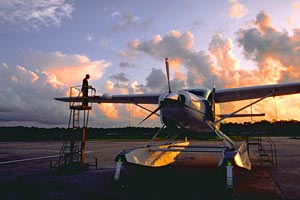
![]() I always cringe
when I see photos of otherwise perfectly planned structures, such as
environmentally conscientious oil producing platforms, being built along the
river in a rainforest or on a lagoon near the ocean, with a long ugly red
earth scar of a runway bulldozed across the background landscape. If for no
other reason than to lighten the load on the already over-burdened
environment, every company operating in an environmentally sensitive
swamp, river, or rainforest area should operate an amphibious Caravan.
I always cringe
when I see photos of otherwise perfectly planned structures, such as
environmentally conscientious oil producing platforms, being built along the
river in a rainforest or on a lagoon near the ocean, with a long ugly red
earth scar of a runway bulldozed across the background landscape. If for no
other reason than to lighten the load on the already over-burdened
environment, every company operating in an environmentally sensitive
swamp, river, or rainforest area should operate an amphibious Caravan.
![]() Another equally important use for
the amphibious Caravan, would be for flying tourists for the developing
eco-tourism business. Not only is the aircraft environmentally friendly, but
it is safe, quiet, comfortable, and affords an unobstructed view for all the
passengers in flight. Water front property is in demand for 5 star hotels
and resorts, and many of them could be services by Caravans if they did not
have to depend on having an expensive destructive runway built nearby.
Another equally important use for
the amphibious Caravan, would be for flying tourists for the developing
eco-tourism business. Not only is the aircraft environmentally friendly, but
it is safe, quiet, comfortable, and affords an unobstructed view for all the
passengers in flight. Water front property is in demand for 5 star hotels
and resorts, and many of them could be services by Caravans if they did not
have to depend on having an expensive destructive runway built nearby.
If I had my way there would be
amphibious Caravans operating all over the world: along the Nile, off the
Zambezi River, in the Okavango and the Pantanal, deep in the Congo, into the
Orinoco and the Amazon, flying out of Darwin and the Gulf of Carpentaria,
and the harbors of South Africa, the Fiji Islands, Indonesia, Thailand,
Madagascar, the Mekong Delta, the Maldives, you name it. Green Caravans.
And, if anyone is interested, I will show them how it can be done.
Article and Images by John S Goulet
![]()
Use the attitude indicator as your guide back to Knowledge Based Stories.
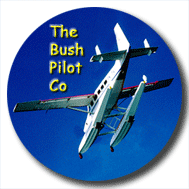 Top of this page.
Top of this page.
The Bush Pilot Company
Last modified
March 05, 2006 .
© Virtual Horizons, 1996.
